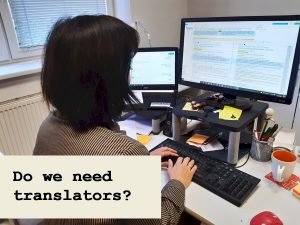The article is addressed to all people who use translation services such as Google Translate, but also to translators and students of translation.

Translators, or, if you prefer, web applications generating machine translations, are certainly one of the most successful services offered by technology companies such as Google, Microsoft, Apple, Amazon and so on. We can safely compare them to successful projects in the so-called sharing economy, such as Airbnb for sharing accommodation or Uber for providing personal transportation. The common denominator is that marketing opportunities are made available to service providers without taking responsibility and, unfortunately, many times without respecting the laws of the country in which the service is provided. In the case of automated translation, this is a service for which the provider is also not responsible, both for the unpaid and the paid form of this service. In the case of accommodation services, such an approach makes it possible to generate income for each property owner, but on the other hand, it also makes it possible to circumvent the regulations in force. The situation is similar in the case of classic taxi services versus Uber-type services.
In the case of automated translation, breaking the law is not an issue. Providing a translation of relatively sufficient quality for free makes customers not understand why they should pay for translation services if the translators provide translations for free. I do not dispute the benefits of this service for many areas, from tourism to Internet commerce, but I feel it necessary to explain the difference between automated robotic translation and professional translation services. IT companies are increasingly tending to ‘cut’ from the translation and localisation industry pie, much as they do with accommodation services, taxi services and the like. It is only natural that their marketing gives customers the impression that the machine-generated translation is almost perfect and the translators are just editing it. This also opens up the possibility of providing translation services to people who would not have dared to do so without the help of a machine translator. The possibility of involving experts from other fields in translation is also a benefit.
So where is the difference between translators and professional translators? Clearly, it is in the responsibility that the translator bears for the translation. Translators, especially since the advent of so-called NMTs, i.e. translators based on neural networks, generate translations that at first glance sound as if they have been translated by a human. However, they are still based only on algorithms that “calculate” the translation from pre-processed bilingual texts. For this reason, the current trend is to build specialized translators that are “trained” on translations from that specific domain. However, if you try to translate a text from another domain with their help, the result will be nonsensical texts, even though they may look fluent at first glance. So the first problem with translators is their unpredictable quality or poor quality. For example, an ordinary translator will be able to translate 80% of sentences perfectly, but 20% will contain errors of minor or even critical importance. However, no one knows at which point such an error will occur. For this reason, however well a machine-translated text is translated, it needs to be checked by a translator to eliminate these errors. Machine translation providers try to convince customers that they will only pay for the 20% of bad and corrected translations. So the translator is expected to look for a needle in a haystack, but only gets paid for the number of needles he finds.
Another dangerous characteristic of NMT translators is the failure to maintain terminological consistency in translation. This means that in one place in the text a different translation of a word or phrase will be used than in another place. This is due to the fact that the translator evaluates each sentence independently. Even more dangerous are so-called omissions, where the translator tries to maintain the flow of the text at the cost of omitting information that does not “fit” into the translation. In this way, the customer does not receive information that may be important to them. Differences in language systems also give rise to automatic translations with opposite meanings. Imagine, for example, a sentence in the instructions that informs you that you can use an electrical appliance in the bath instead of a warning that the appliance cannot be used in the bath.
Modern NMT translators offer us help with translations from a large number of languages. They are made possible by technology that uses a different language combination to translate between languages for which it has not been possible to obtain a sufficient number of bilingual texts. Again, however, there is a catch. If the translator is unable to generate a translation in a given language combination, it may translate the text into another language. So again, there is a need for the translator to review the text and translate such sentences anew.
Automated translators are a huge asset not only for people who do not know a foreign language, but also for professional translators. However, they do not serve them to understand the original text, but to speed up the pace of translation. However, if the market pushes prices down too much, it forces translators to work superficially, increasing the risk of overlooking an error caused by machine translation. Together with the fact that, thanks to translators, even so-called amateur translators dare to translate, translators also contribute to the overall lowering of the quality of the translation. How to deal with this situation? The customer needs to be aware of the purpose of the texts and the risk of any mistakes in the translation. They must then choose the appropriate translation method. Translation companies currently offer a wide range of services, from automated translation – translation by the translator of their choice, which has the best chance of translating the text type, post-editing machine translation – the translator tries to eliminate the biggest critical errors in the machine translation, to translation by a professional translator, on which the customer can fully rely and for which the translation company bears full responsibility. Conversely, the first two types of translation – machine translation and post-edited machine translation – should include a warning to the customer that the text is generated by a computer program and may contain errors. Discussions are underway within the EU institutions on the introduction of a generally applicable regulation that would inform the customer and thus reduce the risk of serious accidents caused by the use of incorrect, computer-generated translations.
Thus, despite the increasing performance of computers and the improving quality of automated translators, the role of the translator remains indispensable.
